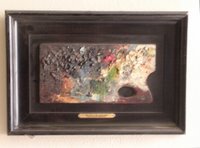
From February through December, 1915
San Francisco hosted a world's fair
to celebrate the opening of the Panama Canal
(and the city's recovery from the 1906 earthquake)
And it looks like no expense was spared
to engage 44 sculptors
to make (mostly) temporary plaster confections
to adorn the grounds
(as well as display marbles and bronzes
in the Palace of Fine Arts)
This was in the midst
of a golden age of American sculpture,
and a sculptor, Karl Bitter,
was the guiding spirit
in assembling the great sculptors of his day.
Mostly, sculptors were chosen from the east coast,
like Borglum, French, and Grafly.
(so Chicago's Laredo Taft wasn't there)

But there were two pieces by Grafly's top student,
Albin Polasek,
who had recently won the Prix de Rome
and made these pieces
while living there at the American Academy.
He would later move to Chicago,
join the Palette and Chisel,
and head the sculpture department at the Art Institute
following the reign of Loredo Taft.

This piece, called "The Sower"
had something of a controversial history
after it was purchased by the Art Institute
and displayed on Michigan Avenue.
Why does this farmer have his pants off ?
City Hall demanded that the offensive statue be removed,
and the case went to court,
where the A.I.C. won the right
to display whatever it wanted on its own property
(even if that property was owned by the city)

But sadly,
the museum would soon be hit
by a force much more powerful
than local prudery:
Iconoclastic Modernism.
And "The Sower" would languish
in the dark basement of the museum
for the next 80 years,
until it was given
to the Chicago Botanical Garden
about 5 years ago.
(where these two pictures were recently taken)
(A pictorial tour of art at the expo
may be found
here,
and don't skip the
introductory essay by the great sculptor, Alexander Stirling Calder.)





 Jerry Ruiz
Jerry Ruiz Phil Renaud
Phil Renaud
 Erroll Jacobson
Erroll Jacobson Delawn,
Delawn,









